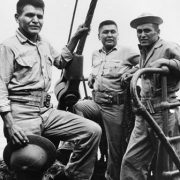kudos Affiliates! summer 2011
As summer heats up, so do Affiliate accomplishments. Way to go Affiliates!
The Perot Museum of Nature and Science (Dallas, Texas) has received a $4.4 million gift from the Texas Instruments Foundation bringing the total within $29 million of its $185 million fundraising goal.
The African American Museum in Philadelphia was awarded $45,000 from the John S. and James L.Knight Foundation, as part of a community-wide contest to inspire and enrich the city entitled Knight Arts Challenge Philadelphia. The program entitled “RAAMP It Up Wednesdays” will showcase local artists by presenting commissioned dance and gospel performances through free weekly concerts at the museum’s Seventh Street Plaza.
The Putnam Museum (Davenport, Iowa) was awarded $35,000 by the Davenport Riverboat Development Authority for an upgrade to the River, Prairie and People exhibit at the museum.
The Institute of Museum and Library Services (IMLS) announced Michigan State University Museum (East Lansing, Michigan) was one of 31 awards for the Conservation Project Support Grants. Michigan State University Museum was awarded $87,816 to rehouse 16,179 mammal specimens into museum-quality cabinets. In addition, the grant will fund students to assist with project activities.
The Chabot Space and Science Center(Oakland, California) received a grant worth $1.8 million from the Betty Moore Foundation, to develop the Bill Nye Climate Lab exhibition and website, designed to support the science education of youngsters.
The Connecticut Community Foundation awarded Hunt Hill Farm (New Milford, Connecticut) with a $10,000 grant for a New Talent Arts Initiative, to offer professional opportunities to young artists.
The National Museum of Dentistry (Baltimore, Maryland) has been awarded a Give Kids A Smile Champion Grant from the ADA Foundation, and an additional award by the DentaQuest Foundation to help provide every first grader in Baltimore City public schools with educational resources to enhance children’s oral health, and to ensure good oral health practices, particularly those from low-income families.
The Rubin Museum (New York, NY) has been awarded a $270,000 grant from the Henry Luce Foundation for the study of Tibetan Buddhist painting. The three-year grant will advance the work of David Jackson, a renowned scholar on Tibetan Buddhist painting and a consulting curator at the Rubin.
Four Affiliates were winners of the 66th annual Leadership in History Awards, the most prestigious recognition for achievement in the preservation and interpretation of state and local history by the American Association for State and Local History (AASLH):
USS Constitution Museum (Boston, Massachusetts) for The Family Learning Project.
Greensboro Historical Museum, Inc. (Greensboro, North Carolina) for the exhibit Voices of a City: Greensboro, North Carolina.
North Carolina Museum of History (Raleigh, North Carolina) for the exhibit Behind the Veneer: Thomas Day, Master Cabinetmaker.
Museum of History and Industry (Seattle, Washington) for the multimedia project MOHAI Minutes.
















